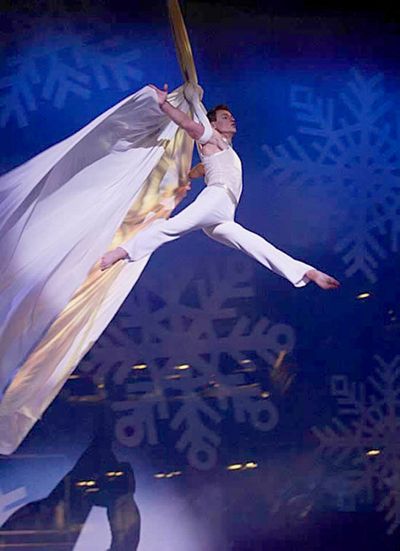Event unites classical music, aerial tricks of Cirque de Soleil
Cirque de la Symphonie brings together classical music with the aerial tricks of Cirque de Soleil

Cirque de la Symphonie combines two venerable European traditions: classical music and the circus. Or, should we say, the cirque.
This Spokane Symphony SuperPops concert features high-flying performers more in the tradition of Cirque de Soleil (although not associated with that group) than the Ringling Bros.
For instance, when the symphony launches into the familiar “Toreadores” from Bizet’s Carmen Suite, performer Alexander Streltsov will take stage center, showing off his aerial moves and his world-class cube-spinning skills.
And not just any cube. It’s a giant cube, made of tubing, and he can spin it so fast it looks like a massive blur.
Streltsov, originally from Russia, has been performing cirque-style acts since he was 12. He’s typical of the performers in Cirque de la Symphonie, many of whom are from Russia.
Elena Tsarkova, for instance, is a graduate of the Moscow Circus School. She’s a contortionist, gymnast and dancer.
Some of her fellow performers, including Aloysia Gavre, will soar high over the stage in feats of aerial acrobatics.
Others, including, the Polish strongman duo Jarek and Darek, will stay more earthbound. They’ll perform feats of strength and balance while the symphony performs the mighty Toccata and Fugue in D minor by Bach. (For a video preview, go to www.cirquedelasymphonie.com.)
As eye-popping as some of these acts should be, the music, under the baton of resident conductor Morihiko Nakahara, promises to be an equally compelling attraction.
The program includes some of the most jaunty and popular works in the entire classical repertoire, including:
• Saint-Saens’ “Dance Macabre” and “Bacchanale.”
• Tchaikovsky’s “Danse des Cygnes” from “Swan Lake” and the waltz movement from Symphony No. 5.
• Rimsky-Korsakov’s “Danse des Bouffons” (“Dance of the Clowns”) from “The Snow Maiden.”
• Dvorak’s “Carnival Overture” and “Slavonic Dance.”
• Khachaturian’s “Valse” from “Masquerade.”
• Bizet’s “Toreadores” and “Danse Boheme” from “Carmen.”
• Two John Williams pieces, one from “Harry Potter and the Sorcerer’s Stone” and one from “Star Wars: Episode II, Attack of the Clones.”
The cirque acts are choreographed to harmonize, in a sense, with these sprightly and well-known musical works.
Cirque de la Symphonie performed a concert with the Seattle Symphony last summer and the Seattle Times reported that the capacity crowd of kids and adults “could not have been more pleased.”
Critic Tom Keogh called it “unexpectedly illuminating.”
“A black tie orchestra kept up a three-ring atmosphere,” he wrote.